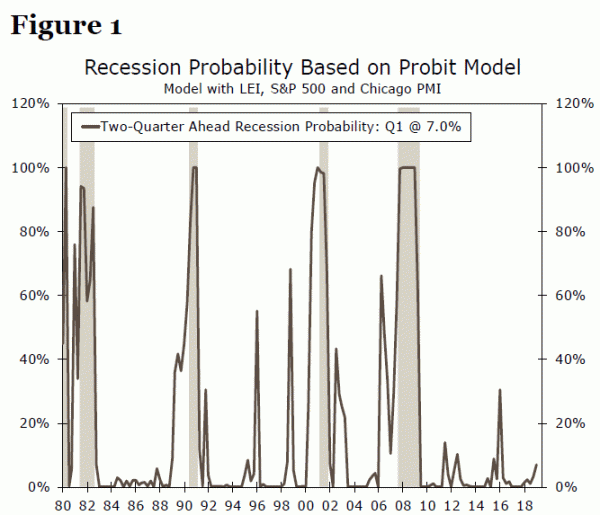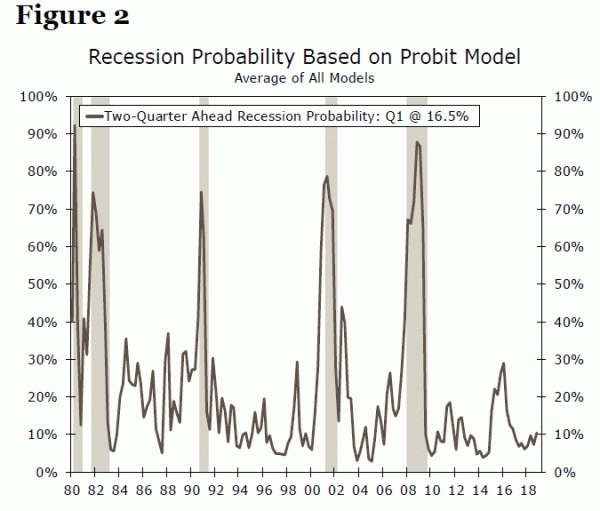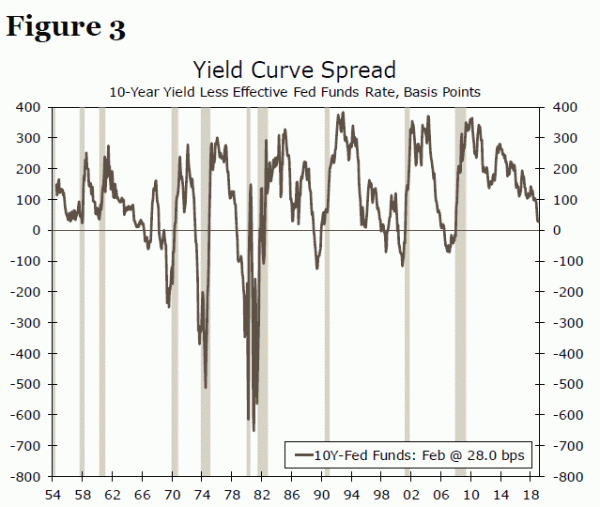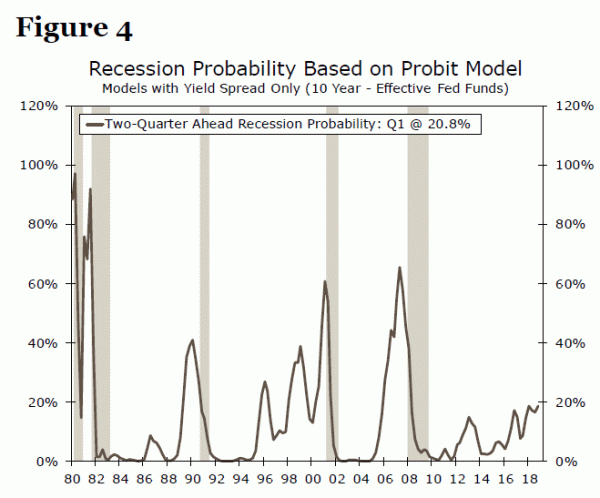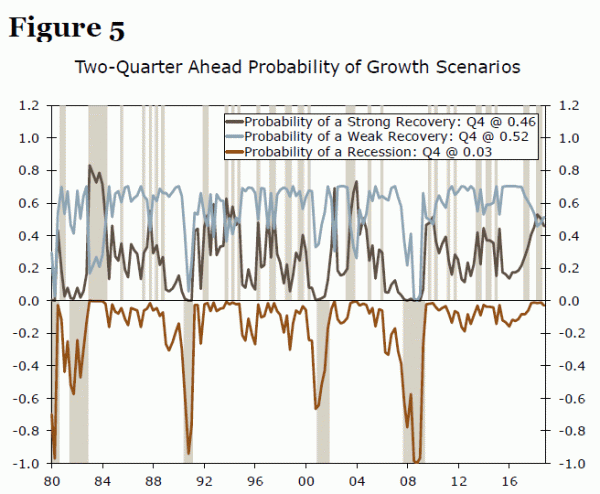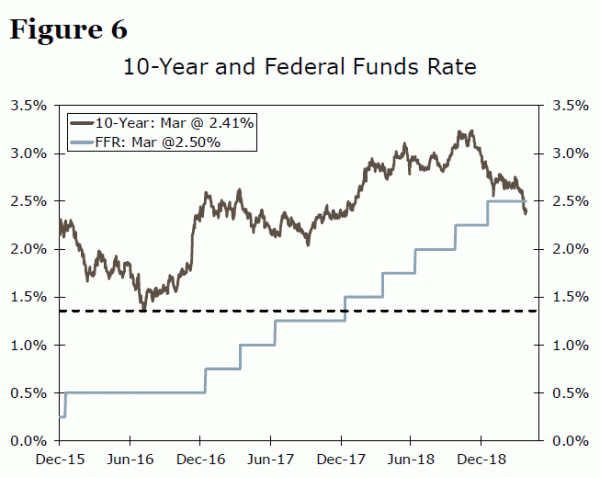“Success is a journey, not a destination. The doing is often more important than the outcome.” – Arthur Ashe
Executive Summary
The yield on the 10-year Treasury fell below the effective federal funds rate last week, resulting in an inversion of the yield curve. The recent inversion has brought heightened market sensitivity of an imminent recession and has caused analysts to question the reliability of the yield curve as a reliable recession predictor. We updated our models to estimate potential risks of a recession in the short-term (next six months) as well as in the medium-term (next couple of years). Our preferred Probit model suggests a low probability of a recession in the next six months (about 7%). The ordered Probit model—which predicts the probability of a recession as well as the strength of a recovery/expansion—shows a low possibility of a recession and trend-like growth for the first half of 2019. Essentially, according to both models there’s little recession risk for the short-term.
In 2017, we developed a new framework to predict recessions up to two years ahead. The predictive power of our framework is significantly greater than yield curve inversion.1 Since 1954, our proposed method predicted all recessions, while the inverted yield curve failed to predict the recessions during 1954-1965. The proposed framework identifies a threshold between the fed funds rate and the 10-year Treasury yield. When the threshold is breached, the risk of a recession increases.
Most of our models suggest minimal short-term recession risk. Although, the yield curve Probit model estimates a 21% probability of a recession, it remains well below the historical threshold. The yield curve would need to invert significantly and remain inverted for weeks, if not months, before it would be a reliable recession signal. The yield curve inverted for at least six consecutive months prior to the past three recessions. Therefore, the probability of a recession remains low, in our view.
To predict recessions, the new framework of our model depends on interest rate hikes. The Federal Open Market Committee (FOMC) remained dovish at its March 20 meeting, as a majority of voting members predicted that the FOMC would keep rates on hold this year. Therefore, we do not foresee a recession in the medium-term. Our GDP forecast for this year is 2.4% and for 2020 is 2.2%. We will continue to monitor the upcoming data for recession signals and will release an update if we notice any significant change to our current recession outlook.
Forecasting Recession Risks for the Short-Term
Using a handful of predictors, a Probit model estimates the probability of a recession in the future. Our official model built in 2007 utilizes the index of Leading Economic Indicators (LEI), the S&P 500 index and the Chicago-PMI employment index as predictors. Our model predicted (in real time) a 58% probability of a recession in Q3-2007.2 In addition, our Probit model did not indicate a recession during 2010-2012 allowing us to avoid joining the “double-dip” camp.
Using data through February 2019, our model suggests a meager 7.0% chance of a recession in the short-term (Figure 1). The key predictor of the model, the LEI, did not show signs of negative growth. A negative LEI value may indicate weakness in the economy. Furthermore, given the positive momentum of the LEI (average growth rate is 0.25% for the past 12 months), it would be very difficult to imagine a recession within the next six months.
In addition to our official Probit model, we built six different Probit models in 2016 to capture the risk of a recession.3 Each model utilizes information from different sectors of the economy to estimate the potential risk posed. The average probability of all models is a low 17%, which represents the potential risk of a recession (Figure 2). Overall, our Probit models suggest low recession risk in the short-term. Nevertheless, there is always the possibility of an unforeseen shock.
The Yield Curve Has Inverted, But No Recession Worries
For the first time since the Great Recession, the yield curve has fallen into negative territory raising concerns of an upcoming recession. The yield curve inverted prior to the past seven recessions (Figure 3). However, the spread remained positive in 1954-1964 and that period experienced two recessions. Including data up to February 2019, the yield curve Probit model estimated a 21% probability of a recession, marking the highest estimate since the Great Recession (Figure 4). However, it’s still lower than the past recessions’ probabilities as a result of the shallow depth and short duration of the current inversion.4 For the past three recessions, the yield curve remained negative for at least six consecutive months before a recession start date. Essentially, if the yield curve were to remain inverted for about six months the probability of a recession could be boosted to a historical high. For now the yield curve Probit model does not necessarily signal that a recession is around the corner.
Predicting Trend-Like Growth for the Near-Term
Economies evolve over time meaning that monetary policy adjustments need to be made to support the expected economic enviroment. For example, the Great Recession ended in June 2009 and the first interest rate hike by the FOMC occurred in December 2015. When compared to historical standards, the painfully slow economic recovery was a major reason for the ultra-accommodative monetary policy stance, even after the recession ended. Therefore, it is important to predict the pace of a recovery/expansion (weaker versus stronger) in addition to the timing of a recession. A weaker recovery prediction (such as the recovery from the Great Recession) suggests a continuation of accommodative monetary policy, as opposed to a stronger recovery forecast, which may support a change in monetary policy. Therefore, we built an ordered Probit framework that simultaneously predicts the probability of a recession and the strength of a recovery/expansion. The model successfully predicted all recessions and pace of recoveries since the 1980s in a simulated, out-ofsample experiment.5 The most recent estimate of the model (based on Q4-2018) suggests a higher chance (52% probability) of trend-like growth, around 2%-2.5% real GDP growth for the first half of 2019 (Figure 5).
Despite the current expansion, trend-like growth is expected for 2019. Typically, economies produce slower growth rates in the late phase of the business cycle, as resource utilization is close to peak level. Therefore, the current 2.9% growth for 2018 may lose some steam. Our GDP growth forecast for 2019 is 2.4% and 2.2% for 2020.
What About the Medium-Term?
Keynes coined the phrase, “in the long run we are all dead.” While Keynes is correct, the medium-term economic outlook is important for decision makers. To estimate medium-term recession risks, we developed a framework in 2017. Our proposed framework identifies a threshold between the fed funds rate and the 10-year Treasury yield. The threshold is breached when the fed funds rate touches or crosses the lowest level of the 10-year Treasury yield in that cycle. When this occurs, the risk of a recession increases. Our framework has successfully predicted each recession since 1954 with an average lead time of 17 months, and several quarters before the yield curve inverted. Therefore, it serves as an effective tool in predicting recessions, and we do not need to wait for the yield curve to invert to predict a recession.
In the current monetary cycle, the threshold was set by the lowest 10-year Treasury yield, 1.36%, on July 5, 2016. At this time, the fed funds rate was at just 0.50%. In December 2017 the FOMC hiked rates to 1.50% for the first time in the cycle, thereby crossing the Treasury yield threshold set in 2016 (Figure 6). Historically speaking, when the threshold is met, a recession or monetary policy change occurs within the next 17 months. Is this time different?
The FOMC has Changed the Monetary Policy Stance
While this time may be different for the inversion of the yield curve as a reliable recession predictor, this time is not different for our framework. The robustness of the framework holds true in real time. At its March meeting, the FOMC changed its monetary policy stance from raising the fed funds rate to a “patient” stance. The market-implied consensus is that the FOMC may not raise rates in 2019 as fed funds futures put a zero probability of a rate hike in 2019 and instead a 76% probability of a rate cut by next year.
In prior long economic expansions, monetary policy shifted due to a “mid-cycle softening” and the FOMC reduced interest rates to boost the economy. This phenomenon occurred in the 1960s, 1980s and 1990s. Therefore, in the current expansion (which is currently the second longest expansion on record), the FOMC may repeat the past exercise of changing its monetary policy stance to fight a mid-cycle economic slowdown. As FOMC members have said that they are data dependent, incoming economic and financial data will affect future FOMC decisions. By the same token, we are monitoring the upcoming data to gauge signals, which could affect our recession call.
Conclusion
Our models suggest there is very low recession risk for the first half of 2019. The ordered Probit model predicts trend-like growth for the upcoming quarters. In the near-term, both the preferred and ordered models propose fundamentals are strong. Our official call for 2019 is a healthy economy experiencing trend-like growth of 2.4%. We will be evaluating the upcoming data and will publish a report if we notice significant developments either against or in favor of our recession call. Furthermore, decision makers should carefully monitor the upcoming data to gauge signs of changes in the momentum of the economy.
1 For more detail about the new methodology see “Do We Need to Wait for a Yield Curve Inversion to Predict a Recession? No.” (September 08, 2017).
2 For a detail discussion about Probit models see out report “Recession Talks in the Spotlight: Should We Worry?” (February 24, 2016).
3. Please see footnote 2 for the reference to the report.
4 The Model predicted a 55% probability in Q1-2007, 61% in Q1-2001 and 41% in Q1-1990.
5 For more detail about the Ordered Probit model see our report, “Predicting the Probability of Recession and Strength of Recovery: An Ordered Probit Approach.” (July 19, 2016)




